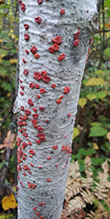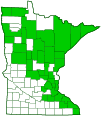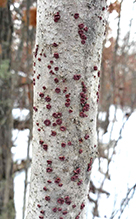Red Tree Brain Fungus
(Peniophora rufa)
Conservation • Description • Habitat • Ecology • Distribution • Taxonomy
|
|
||||||||||||||
Description |
Red Tree Brain Fungus is a common, distinctive, wood-decaying fungus. It occurs throughout the northern Hemisphere worldwide. It is common in Minnesota. It grows on the fallen logs and branches of several tree species in the genus Populus. In Minnesota, these include quaking aspen, bigtooth aspen, and balsam poplar. It also grows on willows (Salix spp.). It obtains its nutrients from dead wood (saprobic). It may also grow on living trees (parasitic), sometimes causing disease and even death of the host (pathogenic). The fruiting body is wart-like, 1⁄16″ to ⅜″ (2 to 10 mm) in diameter, and 1⁄32″ to 1⁄16″ (1 to 2 mm) thick. It lies flat on the wood (resupinate), and it bursts through the still-attached bark. When it first appears, it is red to orangish red, and it sometimes has a dusting of whitish or grayish powder (pruinose). The surface is waxy and is wrinkled with wavy lines. As it ages, it turns wine red, it becomes more or less circular, and it is attached to the surface just in the middle, with the margins free and spread outward. Older specimens are purplish. The flesh is hard and whitish to grayish. The spore print is white. |
Similar Species |
Habitat and Hosts |
Quaking aspen, bigtooth aspen, and occasionally other hardwoods |
Ecology |
Season |
Spring through fall |
Distribution |
||
|
Sources |
|
| 2/12/2024 | ||
Occurrence |
||
Common and widespread |
||
Taxonomy |
|
Kingdom |
Fungi (Fungi) |
Subkingdom |
Dikarya |
Phylum |
Basidiomycota (Basidiomycete Fungi) |
Subphylum |
Agaricomycotina (Higher Basidiomycetes) |
Class |
Agaricomycetes (Mushrooms, Bracket Fungi, Puffballs, and Allies) |
Subclass |
Agaricomycetidae |
Order |
Russulales |
Family |
Peniophoraceae |
Genus |
Peniophora |
Subordinate Taxa |
|
|
|
Synonyms |
|
Cryptochaete rufa Hymenochaete rufa Sterellum rufum Stereum rufum Thelephora rufa Xerocarpus rufus |
|
Common Names |
|
Red Tree Brain Fungus |
|
Glossary
Parasitic
Obtaining nutrients from another living organism.
Pruinescence
A waxy or powdery dust or bloom that covers the underlying coloration and gives a dusty or frosty appearance. Adjective: pruinose.
Resupinate
In fungi: referring to the fruiting body lying flat on the surface of the substrate, without a stalk or a cap. In orchids: referring to flowers twisted 180° at the base during development so that when mature the upper petal appears to be the lower.
Saprobic
A term often used for saprotrophic fungi. Referring to fungi that obtain their nutrients from decayed organic matter.
Visitor Photos |
||
Share your photo of this fungus. |
||
This button not working for you? |
||
N. G. Carlson |
||
 |
 |
|
Luciearl |
||
 |
||
 |
||
 |
||
MinnesotaSeasons.com Photos |
||
|
||
|
||

Slideshows |
|

Visitor Videos |
||
Share your video of this fungus. |
||
This button not working for you? |
||
|
Other Videos |
||
Red tree brain fungus / Peniophora rufa |
About
Sep 30, 2014 The tree brain fungus fascinatingly forms small red cushion-shaped structures on the decaying wood of aspen and cottonwood trees, although sometimes it parasitizes them! You can easily see where it gets its enigmatic common name from. It really sticks out when you see it on a walk in the woods. |

Visitor Sightings |
||
Report a sighting of this fungus. |
||
This button not working for you? |
||
N. G. Carlson |
Location: Ramsey, MN |
 |
Luciearl |
Location: Lake Shore, MN |
 |
Luciearl |
Location: Lake Shore, MN |
 |
Luciearl |
Location: Fairview Twp. |
 |
Luciearl |
Location: Fairview Twp. |
 |
MinnesotaSeasons.com Sightings |
||
|

|
Created: 2/12/2024 Last Updated: © MinnesotaSeasons.com. All rights reserved. |


